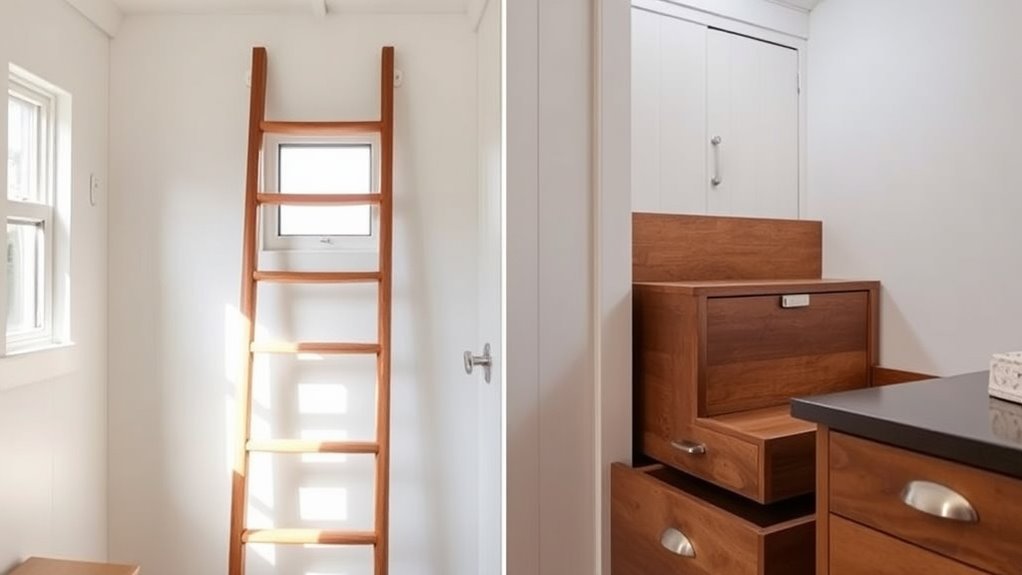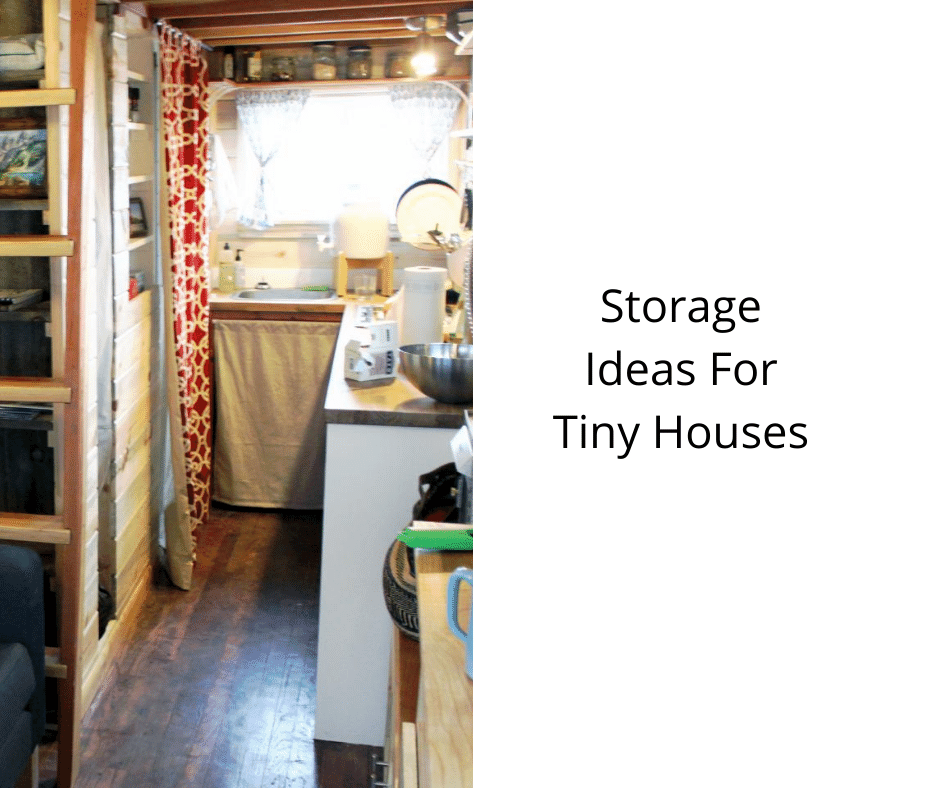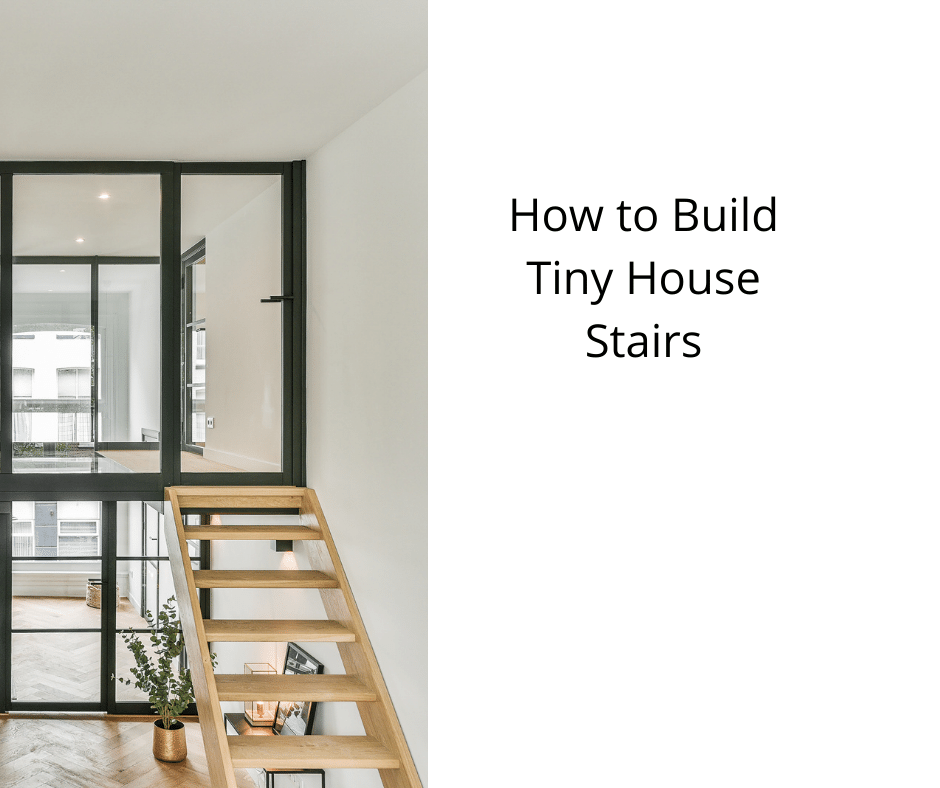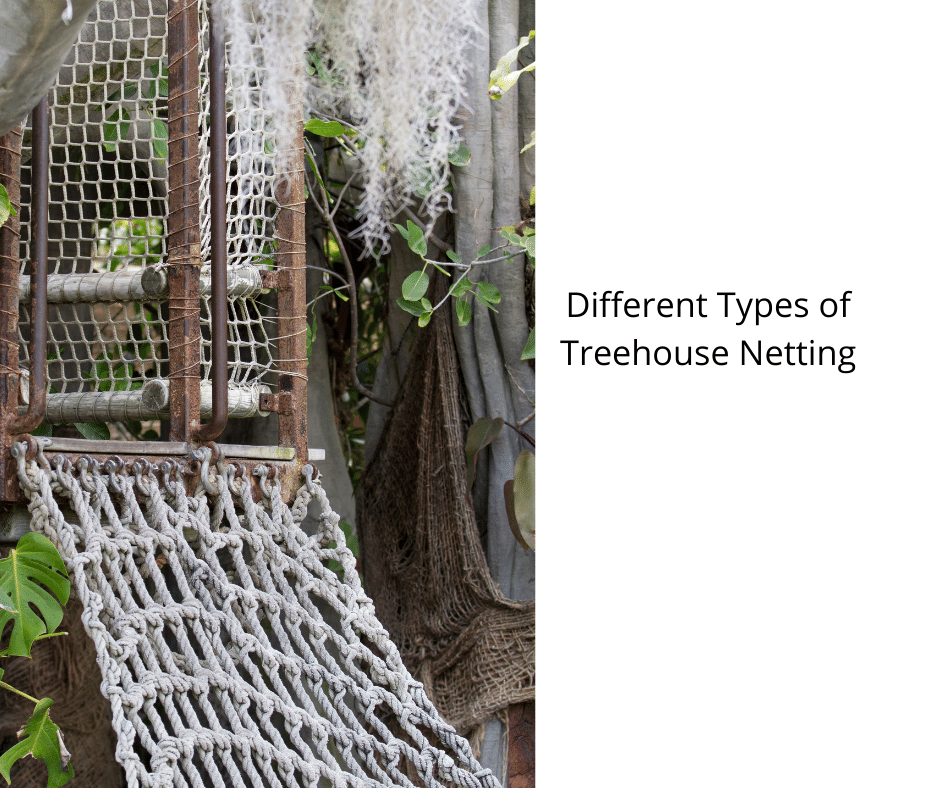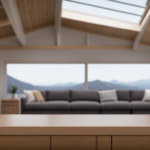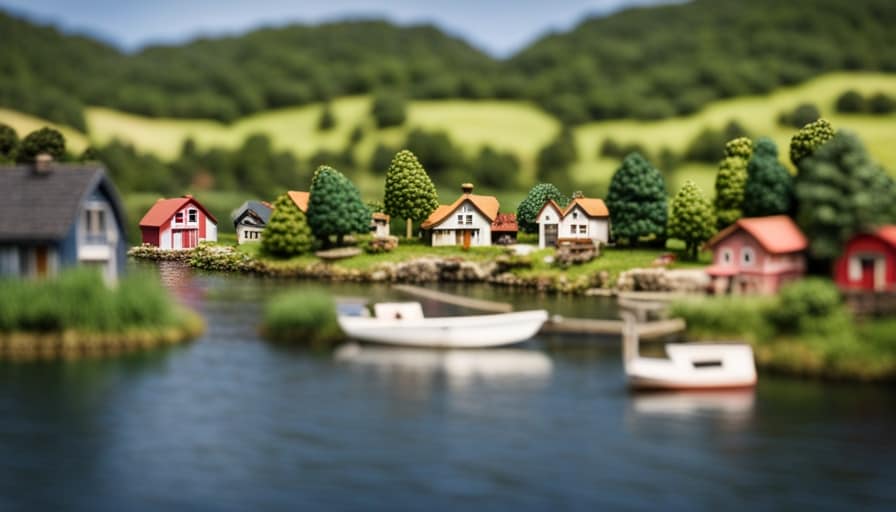When choosing tiny-house stairs, you’ll find ladders save space but can be less safe, especially for mobility challenges. Ship stairs offer safety with handrails but take up more room and may require custom design. Drawer stairs combine storage with stairs but might be harder to navigate. Each option balances space efficiency, safety, and practicality. To discover which alternative best suits your needs and enhances your tiny home, explore the details ahead.
Key Takeaways
- Ladders are space-efficient and easy to install but less safe for mobility-impaired users.
- Ship stairs save space with safety features like handrails but may require custom design and installation.
- Drawer stairs integrate storage into steps, maximizing space but may be less accessible for some users.
- Alternating tread stairs are compact and space-saving but can be steep and challenging for balance.
- Spiral stairs are highly space-efficient and visually appealing, though they often need custom work and maintenance.
Comparing Space Efficiency and Safety Features
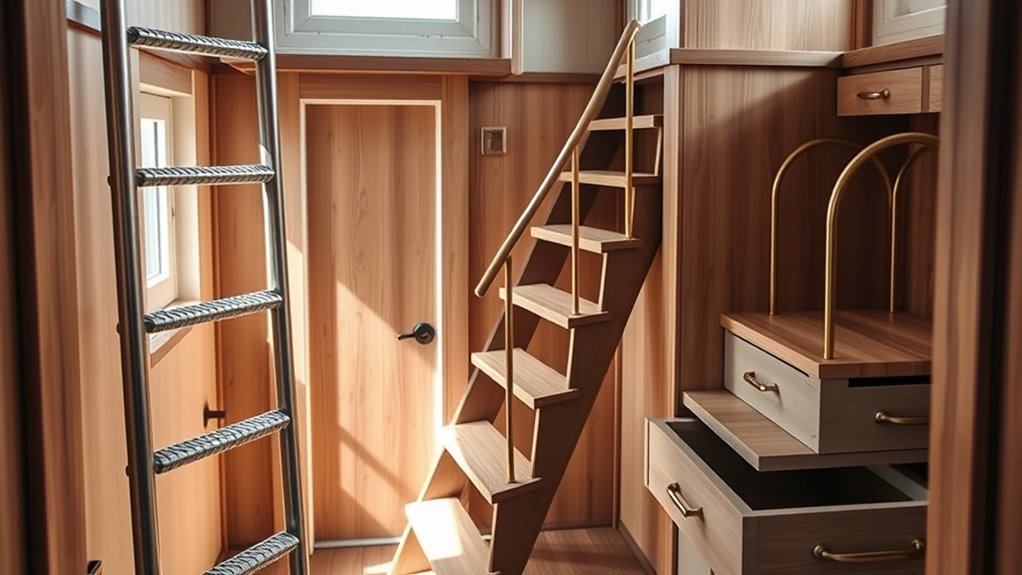
When choosing tiny-house stairs, balancing space efficiency and safety is essential. Ladders take up minimal horizontal space thanks to their vertical design, making them perfect for tight areas. However, they lack handrails and can be steep, increasing fall risk. Ship stairs, including spiral and winding options, require more space but often feature handrails and wider treads, boosting safety. Drawer stairs combine storage with traditional steps, maintaining safety features like locks to prevent accidental openings. Alternating tread stairs save space by staggering steps but demand careful footing, which might be challenging for some. Foldable or retractable stairs offer flexibility, maximizing space and freeing up space when not in use. Each option balances space and safety differently, so consider your specific needs and mobility when choosing. Safety features like handrails and non-slip surfaces are important considerations that can influence your decision.
Evaluating Practicality and Ease of Use
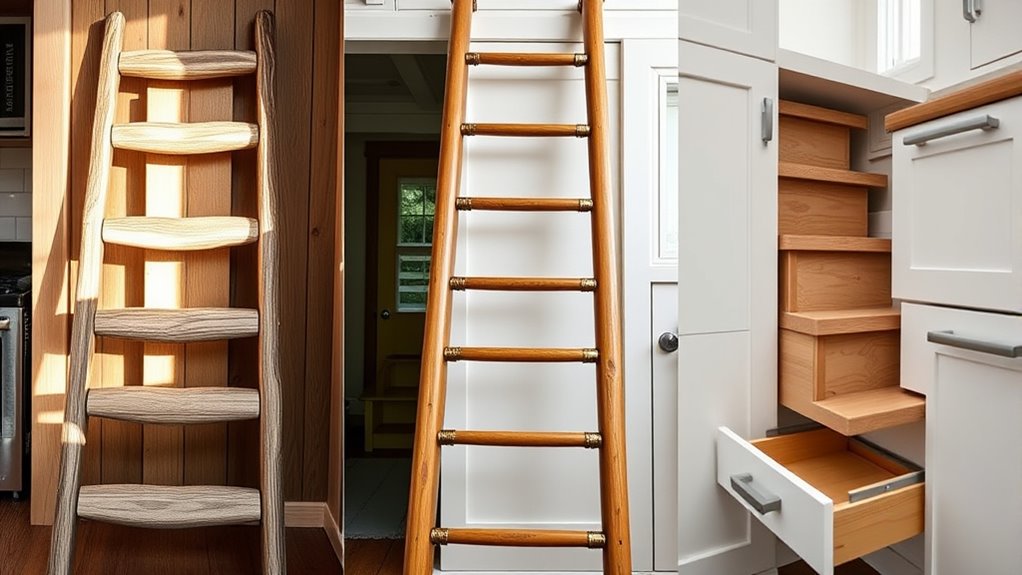
Evaluating how practical and easy stairs are to use in a tiny house helps determine the best fit for your lifestyle. Ladders are simple and quick to install but can be unsafe or difficult for people with mobility issues. Ship staircases are compact and efficient, yet may require custom design and installation. Drawer stairs combine access with storage but might be less accessible for those with limited mobility. Alternating tread stairs are space-saving and safe if used carefully, but their steepness can pose challenges for balance. Spiral staircases are space-efficient and visually appealing but often need custom work, making them more complex to install and maintain. Your choice depends on balancing safety, comfort, and ease of use within your tiny house’s unique space and your personal needs. Furthermore, the materials and design features of each option can influence their overall practicality and safety, especially for frequent use. Considering projector technology and setup requirements can also impact how easily you can incorporate your chosen staircase into a multifunctional living area.
Incorporating Storage and Aesthetic Elements
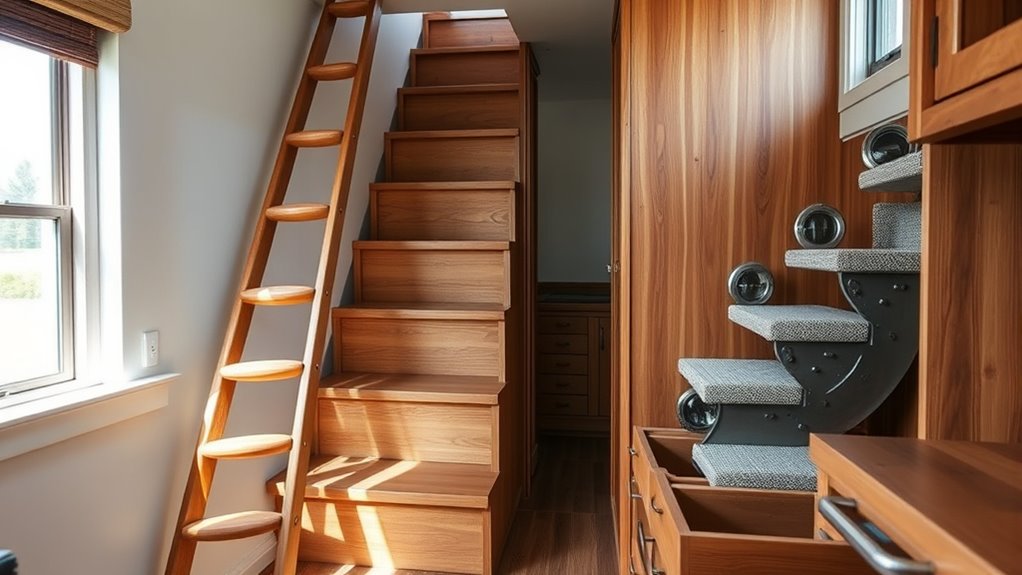
Incorporating storage and aesthetic elements into stair alternatives allows you to maximize your tiny house’s space while enhancing its visual appeal. You can add hidden compartments, such as drawers or shelves within each step, to store belongings discreetly. Pull-out pantries and under-stair cabinets provide practical storage solutions without sacrificing floor space, keeping your home organized. Adding cubbies, shelves, or drawers to the sides or back of stairs offers accessible storage for cleaning supplies, linens, or toys. Aesthetic enhancements, like custom designs with wood or metal, decorative railings, or integrated lighting, make your stairs a stylish feature. Choosing colors that match your interior creates harmony, while carpeted or uniquely crafted stairs add comfort and elegance. These elements turn functional stairs into integral, attractive parts of your tiny house.
Frequently Asked Questions
Are Stair Alternatives Suitable for All Age Groups?
You might wonder if stair alternatives suit everyone. In reality, they’re not safe or practical for all age groups. Kids risk falling from ladders, while seniors struggle with steep or narrow options. For universal accessibility and safety, a single-level home with ramps or gentle slopes works best. Stair alternatives often favor space-saving or aesthetic goals but fall short in providing safe, easy access for children, elders, and those with mobility challenges.
How Do Stair Options Impact Overall Tiny House Regulations?
You might not realize it, but your stair choice can substantially impact tiny house regulations. For example, stairs must meet minimum width and height standards—like a 17-inch minimum width—affecting design options. Ladders and alternative stairs require specific rung measurements and safety features to pass code. If you ignore these rules, your tiny house might not be approved. Balancing safety with space-saving needs is essential to stay compliant and ensure safe egress.
Can Stair Modifications Be Made After Initial Installation?
Yes, you can modify stairs after installation. You might disassemble and reconfigure modular designs like stacked boxes or add storage with drawers or pull-outs. Be sure to check the load capacity and maintain proper alignment for safety. You may need to replace brackets or adjust dimensions, but always follow manufacturer guidelines or consult professionals. Safety and structural integrity should guide any changes, ensuring your stairs remain secure and compliant.
What Are the Maintenance Requirements for Different Stair Types?
Think of your tiny house stairways as living, breathing parts of your home that need regular care. For ladders, you’ll tighten bolts and treat wood to ward off warping. Traditional stairs demand cleaning and inspection for creaks. Ship ladders require hinge checks and corrosion prevention. Built-in storage stairs need drawer maintenance and surface refinishing. Keep a vigilant eye, and your stairs will remain safe and sturdy, supporting your daily adventures with grace.
Are There Cost Differences Between Stair Alternatives and Traditional Stairs?
You’ll find that alternatives like ladders or foldable stairs are generally more affordable than traditional stairs, which can cost between $1,900 and $5,000 to install. Ladders tend to be even cheaper, especially if you choose simple designs. However, keep in mind that custom or intricate options, like spiral stairs, might increase costs. Overall, choosing space-saving and simple designs usually helps you save money on installation and materials.
Conclusion
Choosing between ladders, ships, and drawers for tiny-house stairs means weighing space efficiency against safety. Ladders save room but may feel unstable, while ships add charm but can be tricky to navigate. Drawers offer hidden storage but might sacrifice accessibility. Ultimately, your decision balances practicality with style—each option has its trade-offs. By understanding this contrast, you can select the solution that best fits your lifestyle, blending safety, convenience, and aesthetic appeal seamlessly.
I’m Theodore, and I love tiny houses. In fact, I’m the author of Tiny House 43, a book about tiny houses that are also tree houses. I think they’re magical places where imaginations can run wild and adventures are just waiting to happen.
While tree houses are often associated with childhood, they can be the perfect adult retreat. They offer a cozy space to relax and unwind, surrounded by nature. And since they’re typically built on stilts or raised platforms, they offer stunning views that traditional homes simply can’t match.
If you’re looking for a unique and romantic getaway, a tree house tiny house might just be the perfect option.
